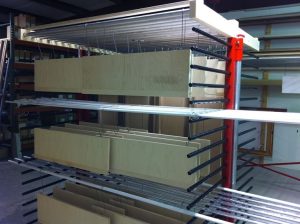Can Exploitation ever be a Good Thing? – Part 8 of 11
In the last OneThingology Blog post, we talked about Step ZERO, or determining our Goal. Having already covered the first of the five step process in the two articles prior, finding or identifying the constraint, today we will look at step 2, Exploit the Constraint.
For context, lets review our Five Steps one more time (I may repeat myself often as it relates to these 5 steps).
- Identify the Constraint
- Exploit the Constraint
- Subordinate every other decision to the Constraint
- Elevate the Constraint
- Rinse and Repeat
The word Exploit is very often used in the negative context (i.e., the rich exploit the poor, employers exploit their workers), but in this case, it’s the positive context we are talking about. We are going to exploit the Constraint to help us reach our “Goal”. Thinking of the most common positive perception of the use of the term, we would utilize a resource to it’s fullest potential, make it as productive as possible, and although that is necessary, it is not sufficient.
The real power in understanding and utilizing Theory of Constraints in our manufacturing businesses is the clear understanding of dependent events, understanding that a whole bunch of local optima does not equal global optima (think of the Daytona 500, all the cars going as fast as they can does not always lead to a record setting race time. More often than not, it leads to some spectacular crashes). We learn to focus our attention on the constraint, exploit the constraint, make certain we don’t waste the little we have, and as unintuitive as it sounds, ignore the other stuff (don’t improve the things that are not the constraint, which we will talk more about in the next post).
I am still amazed at how unimaginative I was when I finally discovered my first constraint. Our knee jerk reaction was to throw money at our constraint rather than think about our options (apparently it’s easier to throw money at perceived issues than to use our heads). As mentioned in an earlier post, my first constraint was my finish room, and my knee jerk reaction to having identified that constraint was to purchase a second Kremlin air assist pump. That cost me thousands of dollars, and saved me all of maybe 10 minutes a day.
So, before you go down the Bobbo is an idiot path too terribly far, I saw other cabinetmakers make the same type of mistake over and over again. It seems it is human nature when cash flow supports it (and sometimes when cash flow does not support it) to throw money at our problems. It did not happen overnight, but in time, our intuition kicked in, and we all started thinking through this constraint with the dependent events before and after it in mind, and came up with some very simple, and in most cases zero cost solutions to Exploit our Constraint.
The first, and in hind sight the most obvious was to make sure the finish room was ALWAYS operating. Staggered lunch and breaks made sure we did not waste the little we had. And here are just a few of the many things we did over the years to exploit our finish room when it was the constarint:
- Choosing finish products that in the past seemed too expensive, but in light of this being our constraint now seemed like a bargain in eliminating a coat or step in the process.
- Always, always, always have a backup finisher available (most of the time, that was me).
- Offloading processes from the finish room to other areas, like bringing primed and sealed products out of the finish room for others to sand rather than the finish operator doing those processes.
- Converting from a face frame cabinet manufacturer to a full access cabinet manufacturer to eliminate the vast majority of the finish content in cabinets (we no longer had to finish cabinet boxes, or the frame of a cabinet).
- For some of our painted projects, switching from a 2 sided raw MDF product for our one-piece doors to a raw one side, melamine one side so we could eliminate everything involved with finishing two sides of a door (dry time, flipping the doors over, etc.).
- For stained projects and 5 piece door painted projects, going from flat finishing to vertical finishing, again, to eliminate the dry time, and all that is involved with handling a finished part multiple times.
- Remodeling our showroom to only show things we could purchase from Conestoga pre-finished so when we were busy, we could outsource to keep the finish room from becoming the constraint (once we could outsource all of our finishing when needed, the finish room was no longer our constraint).
The biggest single improvement we made that impacted our finish room constraint (before outsourcing finished product was an option) was converting from a face frame manufacturer to a full access manufacturer, but right behind it was deciding to finish vertically. Don’t get me wrong, we had several false starts (my finisher at the time was 100% against this, and did everything in his power to skew the test results), this was the hardest single improvement I was ever involved in, we went through dozens of racking revisions, multiple hanging methods (i.e., hooks, eyelets, etc.). It was hard, but it paid off big time once we got it working well.
No one ever said continuous improvement was easy, but it can pay very large dividends if you are willing to invest time, energy and brain cells into it. Theory of Constraints guides you in the right direction, helping you focus all your attention on the one thing that will provide the biggest return on investment (the one thing that can change everything). Exploiting Constraints may be challenging, but in time, you will master the process, and it will become fun, even exciting, as it will help you make more money now and in the future.
Please keep in mind that a lot of the experiences I describe in these posts took place long before there was a Cabinotch Innovative Solutions, so a pre-finished box with a blind frame attachment methodology was not part of our thought process in prehistoric times (yes, I’m an old guy), thus we decided that Full Access Cabinetry would provide the solution to our constraint, but had there been such a system at that time, we very well may have come to a totally different conclusion. Today, with the availability of pre-finished component parts, there is no excuse for any cabinetmaker, frame or full access to allow his or her finish room to be his or her constraint, and no barrier to keep a cabinetmaker from selling both construction methods.
In fact, if I had to start a cabinet business from scratch today, I believe I would pursue a low investment, low overhead model, outsourcing all of my doors, drawer fronts, drawer boxes and cabinet components as opposed to the high investment, high overhead manufacturing model I chose in the past. Being able to focus on marketing, sales, design, assembly and installation, with an emphasis on design skills and custom cabinetry, I believe I could make an even better margin, with a lot less headaches, and a whole lot less stress and risk (I think there might be an entire blog series waiting to be developed around this low investment, low overhead business model).
In the previous article in this series, we covered step ZERO, or determining our Goal. In our next article in this OneThingology series, we will delve into the third step, Subordinate every other decision to the Constraint.
To make sure you won’t miss a crucial part of this discussion, enter your email address in the Subscribe to Blog via Email field on the right, and each time one of us adds a blog post, you will automatically be notified. Oh, and you won’t hurt our feelings if, depending on where you are seeing this, you Share, Like, Plus or Re-tweet it (there are buttons somewhere on this page to help you with that).
May the Lord bless the work of your hands, heart and mind.



Thanks as always for sharing your knowledge and experience.
I’m always looking for new ways to streamline or skip unproductive steps in my process.
As a one man army I appreciate the need for a streamlined outsource based approach.
Looking forward to hearing your thoughts on that.
Mark, in my best attempt at a Chick-Fil-A voice, My Pleasure! I love the thought of chasing down the rabbit hole of a low investment, low overhead model, so keep an eye out for a new series on that topic, possibly right behind the upcoming estimating series.